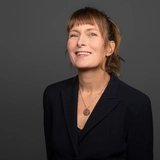
With courage Berlin has already made it through many a crisis. That is why we have taken a look at the past 600 years of history for you and discovered many powerful stories that are unmistakable for Berlin, for Berliners. Let us inspire you.
Largest industrial monument in Europe
The complex of yellow brick buildings stretches for over three kilometres along the Spree. In fact, Oberschöneweide is home to Europe's largest continuous monument of industrial architecture. Once the pumping heart of Berlin's electropolis, the Rathenau-Hallen are now a centre for culture, tech and start-ups: a use entirely in the spirit of its namesake and AEG founder Emil Rathenau.
With the founding of the Allgemeine Electricitäts-Gesellschaft AEG in 1887, the visionary and entrepreneur not only created a global corporation. With his ideas about the use of modern technology, Emil Rathenau electrified the city and thus created the conditions for modern and innovation-driven urban development.
A light goes on for Rathenau in Paris
In 1877, around ten years before AEG was founded, Berlin exceeded the one million inhabitant mark. A unified economic area had come into being with the Kaiserreich in 1871, and with the expansion of the railway network more and more people flocked to make their fortunes in large cities like Berlin. Rathenau works at the August Borsig locomotive factory, at the time the largest in Europe.
Rathenau thinks bigger. Gripped by the possibilities of industrialisation, he is drawn to England, where he spends two years learning and working for different companies. On his return, he set up his own business by buying a mechanical engineering factory. When this was converted into a joint-stock company, he dropped out and tried to establish a telephone network instead. This fails, as does his attempt to persuade Werner von Siemens to introduce electric street lighting in Berlin.
But Rathenau does not give up. At the electricity exhibition in Paris, he became enthusiastic about Thomas Edison's light bulb and convinced him to give him the rights to use it in Germany. And with the light bulb came success. Because anyone who wants to bring modern light into their home needs electricity. And Rathenau founded the Deutsche Edison Gesellschaft, which he transformed into the Allgemeine Electricitäts-Gesellschaft, or AEG for short, in 1887.
Electropolis Berlin
Description
The video introduces the industrial culture in Berlin and shows historical images and shots from today of the Schöneweide industrial landscape. At the end you can see the VisitBerlin logo and a thank you message.The video is subtitled in English. For a transcription, the video should be watched directly on YouTube
Soon there is no longer enough space in the inner city area to generate enough electricity for the increasing power consumption. Rathenau finds the ideal location for his vision of a modern power plant in Oberschöneweide. In 1897, the Oberspree cable works, the most modern factory in Europe, goes online. Instead of steam engines, production is driven by electric motors, powered by the first three-phase power station in Europe, the Oberspree power station.
Over the next 30 years, more halls and plants are added. AEG has long since become internationally successful and employs 3000 people. And Rathenau came up with more and more ideas to bring the innovative power of electricity from the cities to the municipalities. He offers to build power plants locally and to give them the right of first refusal if they can raise enough capital. Emil Rathenau died in 1915. His son Walther continues to run the company as president together with the new managing director Felix Deutsch.
Although parts of the factory are destroyed during the Second World War, it continues to supply electricity as a state-owned enterprise in the GDR. After reunification, however, the cable factory cannot survive on the market and is closed in 1995.
ABOUT BERLIN App
You can also find more powerful stories from Berlin in our ABOUT BERLIN app. You can download it for free for iPhone and Android.


There is a lot to tell. ABOUT BERLIN.





